

BTEC NEW Unit 4 Ass 3 TMC. Research and Report.
Screencast: U4 A3 Task One. Screencast: U4 A3 Task 2: Information and value analysis. Screencast: U4, A3, Value analysis, creative to report sections. The Quality Toolbook: Value Analysis. The Quality Toolbook: Examples of the Value Analysis. The Quality Toolbook > Value Analysis > Examples When to use it | How to understand it | Example | How to use it | Practical variations A product manager at a company that produced nails had received several requests from customers for a nail that could not work loose.
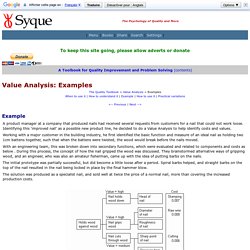
Identifying this 'improved nail' as a possible new product line, he decided to do a Value Analysis to help identify costs and values. Working with a major customer in the building industry, he first identified the basic function and measure of an ideal nail as holding two 1cm battens together, such that when the battens were twisted, the wood would break before the nails moved.
With an engineering team, this was broken down into secondary functions, which were evaluated and related to components and costs as below . Value Analysis in Depth - Canadian Society of Value Analysis. A Value Analysis study is effective in improving the value of a product, process, project or service because it is undertaken in a systematic approach known as a Job Plan.
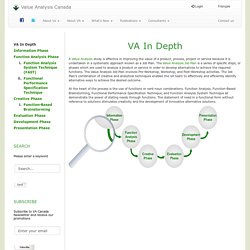
The Value Analysis Job Plan is a series of specific steps, or phases which are used to analyze a product or service in order to develop alternatives to achieve the required functions. The Value Analysis Job Plan involves Pre-Workshop, Workshop, and Post-Workshop activities. The Job Plan’s combination of creative and analytical techniques enables the VA team to effectively and efficiently identify alternative ways to achieve the desired outcome. At the heart of the process is the use of functions or verb noun combinations. Function Analysis, Function-Based Brainstorming, Functional Performance Specification Technique, and Function Analysis System Technique all demonstrate the power of stating needs through functions.
About Value Analysis - Value Analysis Canada. VA VE Overview Value Analysis (VA), also known as Value Engineering (VE), is a systematic and function-based approach to improving the value of products, projects, or processes.
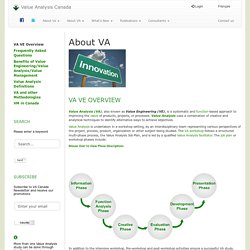
Value Analysis uses a combination of creative and analytical techniques to identify alternative ways to achieve objectives. Value Analysis is undertaken in a workshop setting, by an interdisciplinary team representing various perspectives of the project, process, product, organization or other subject being studied. What is Process Mapping. 61I9 APPLICATION OF VALUE ENGINEERING. Cost reduction of a product through value analysis value engineering. WCECS2012 pp1330 1333. WBDG - Whole Building Design Guide. Introduction Value Engineering is a conscious and explicit set of disciplined procedures designed to seek out optimum value for both initial and long-term investment.
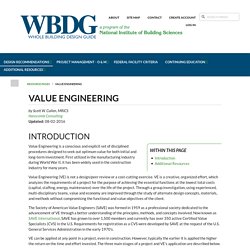
First utilized in the manufacturing industry during World War II, it has been widely used in the construction industry for many years. Value Engineering (VE) is not a design/peer review or a cost-cutting exercise. VE is a creative, organized effort, which analyzes the requirements of a project for the purpose of achieving the essential functions at the lowest total costs (capital, staffing, energy, maintenance) over the life of the project. Through a group investigation, using experienced, multi-disciplinary teams, value and economy are improved through the study of alternate design concepts, materials, and methods without compromising the functional and value objectives of the client.
VE can be applied at any point in a project, even in construction. Planning The benefits are tremendous. Design. What Are the Benefits of Value Analysis? Value Analysis and Function Analysis System Technique. NWhittle Value Analysis. Phases that be Implemented in Value Analysis Procedure. Some of the most important phases that can be implemented in value analysis procedure are as follows: 1.
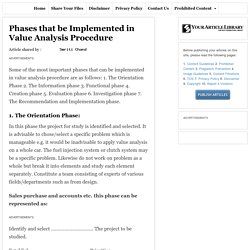
The Orientation Phase 2. The Information phase 3. Functional phase 4. Creation phase 5. Evaluation phase 6. 1. In this phase the project for study is identified and selected. Sales purchase and accounts etc. this phase can be represented as: What is value? - Praxis Framework. An example of value analysis - Praxis Framework. What is value analysis? definition and meaning - BusinessDictionary.com.
The value analysis had concluded that our Director of Operations idea was optimal as we had forecasted significant future profits. 19 people found this helpful Although their Christmas "Rainbow Glitter " line had proved to be a reasonable success, it was noted that some of the dyes used were quite expensive compared to their usual line, a fact that made further value analysis of the line a prerequisite before considering the possibility of a second Christmas line 17 people found this helpful At today's meeting we were shown a value analysis that showed the exact cost of the product when we compared the different material options. 16 people found this helpful.
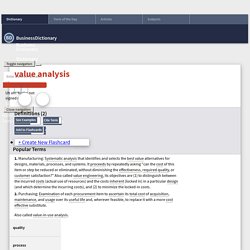
Discover the new ISO 14001:2015! ISO and the environment. ISO 14001 Certification. ISO 14000 Environmental management. UK I LR ISO 45001 Factsheet. ISO 14001 Requirements & Accreditation. Snippets of information on Quality and ISO 9000. Pub100080. Quality Principles - 9000 Store. These are timeless ideas which will help you align your organization with all of your stakeholders: customers, suppliers & employees.
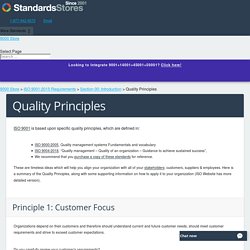
Here is a summary of the Quality Principles, along with some supporting information on how to apply it to your organization (ISO Website has more detailed version). Principle 1: Customer Focus Organizations depend on their customers and therefore should understand current and future customer needs, should meet customer requirements and strive to exceed customer expectations. Do you carefully review your customer’s requirements? How do you know if your customers are satisfied?
Principle 2: Leadership Your organization’s leaders are the top level of management. The captain guides the ship, and likewise Top Management has a responsibility to embrace these principles and your quality management system. Specifically, your organization’s leadership should hold management review meetings to keep your QMS (and organization) running smoothly. Apply ISO 9001 to Baking Cookies - 9000 Store.
How does ISO 9001 apply to a business?
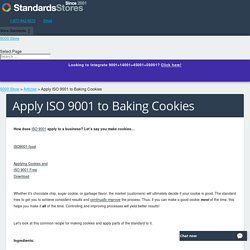
Let’s say you make cookies… Whether it’s chocolate chip, sugar cookie, or garbage flavor, the market (customers) will ultimately decide if your cookie is good. The standard tries to get you to achieve consistent results and continually improve the process. Thus, if you can make a good cookie most of the time, this helps you make it all of the time. Controlling and improving processes will yield better results! Let’s look at this common recipe for making cookies and apply parts of the standard to it.
Applying Cookies. ISO 9000 Series of Standards - What is ISO 9000? Quality Glossary Definition: ISO 9000 series standards ISO 9000 is defined as a set of international standards on quality management and quality assurance developed to help companies effectively document the quality system elements needed to maintain an efficient quality system.
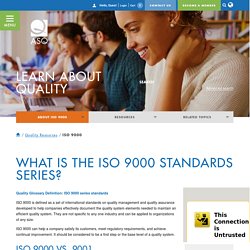
They are not specific to any one industry and can be applied to organizations of any size. ISO 9000 can help a company satisfy its customers, meet regulatory requirements, and achieve continual improvement. ISO 9000 Series of Quality Standards - 9000 Store. What is the ISO 9000 series of quality management system standards?
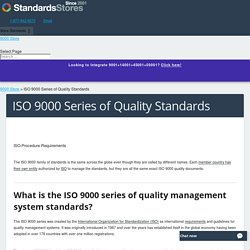
The ISO 9000 series was created by the International Organization for Standardization (ISO) as international requirements and guidelines for quality management systems. It was originally introduced in 1987 and over the years has established itself in the global economy having been adopted in over 178 countries with over one million registrations.
The phrase “ISO 9000 family” or “ISO 9000 series” refers to a group of quality management standards which are process standards (not product standards). ISO 9001 lists requirements, while the other standards in the 9000 family provide guidelines and information. People often say “ISO 9000 certified“, but what they mean is they have met the requirements of the ISO 9001 standard. The series is not industry specific and is applicable to any manufacturing, distribution or service organization. Plan-Do-Check-Act (PDCA) Also known as the "Deming Wheel," "Shewhart Cycle" and PDSA © GettyImagesanyaivanova The PDCA cycle encourages a commitment to continuous improvement. Imagine that your customer satisfaction score on a popular business ratings website has dipped.
When you look at recent comments, you see that your customers are complaining about late delivery, and that products are being damaged in transit. You decide to run a small pilot project for a month, using a new supplier to deliver your products to a small sample of your customers, and you're pleased to see that the feedback from these customers is positive. What you have just done is to go once around a loop called the PDCA Cycle, which helps you to strive for continuous improvements to your business. Quality Timeline - A Brief History of Quality Management. TQM History. Article on the History of TQM. This page describes TQM History. TQM stands for Total Quality Management. 1930s TQM history The history of TQM starts with Elton Mayo’s Hawthorne experiements from 1927 through 1932.
These experiments showed that workers participation in decision making improves productivity. In the 1930s, the Hawthorne plant of the Western Electric Company studied lighting levels, workday lengths, and rest period lengths to maximize productivity. This change in behavior from the employees is now called the Hawthorne effect. Also during the 1930s, Walter Shewhart developed control charts. which are a statistical method to control processes. Total Quality Management History of TQM and Business Excellence BPIR.com. Deming suggested that they can achieve their goal in five years; not many Japanese believed him. However, they followed his suggestions. Maybe the Japanese thought it was rude to say that they did not believe Deming. Or maybe they thought it would be embarrassing if they could not follow his suggestions.
Whatever reason it was, they took Deming’s and other gurus’ advice and never looked back. History & Evolution of Total Quality Management (TQM) The history of total quality management (TQM) began initially as a term coined by the Naval Air Systems Command to describe its Japanese-style management approach to quality improvement.
An umbrella methodology for continually improving the quality of all processes, it draws on a knowledge of the principles and practices of: Introduction and Implementation of Total Quality Management (TQM) Total Quality Management is a management approach that originated in the 1950s and has steadily become more popular since the early 1980s. What Is the Total Quality Management (TQM) Approach? Total Quality Management (TQM) is an approach that seeks to improve quality and performance which will meet or exceed customer expectations. This can be achieved by integrating all quality-related functions and processes throughout the company.
Total Quality Management - TQM. Article: Six Sigma in Education - Apply Lean Principles to Your Sector. Six Sigma and Lean principles drive change, allowing businesses to seek out and eliminate waste, cultivate process improvement, and transform profit margins. But the question is, can they be used in the education sector? Using Six Sigma to Solve Issues in Public School System. Of all the new and innovative applications for Six Sigma, none may be as interesting as one being used in the state of Colorado – applying Six Sigma to all aspects of a public school system. Six Sigma For Dummies Cheat Sheet. From Six Sigma For Dummies, 2nd Edition By Craig Gygi, Bruce Williams, Neil DeCarlo, Stephen R. Covey. Six Sigma For Dummies.